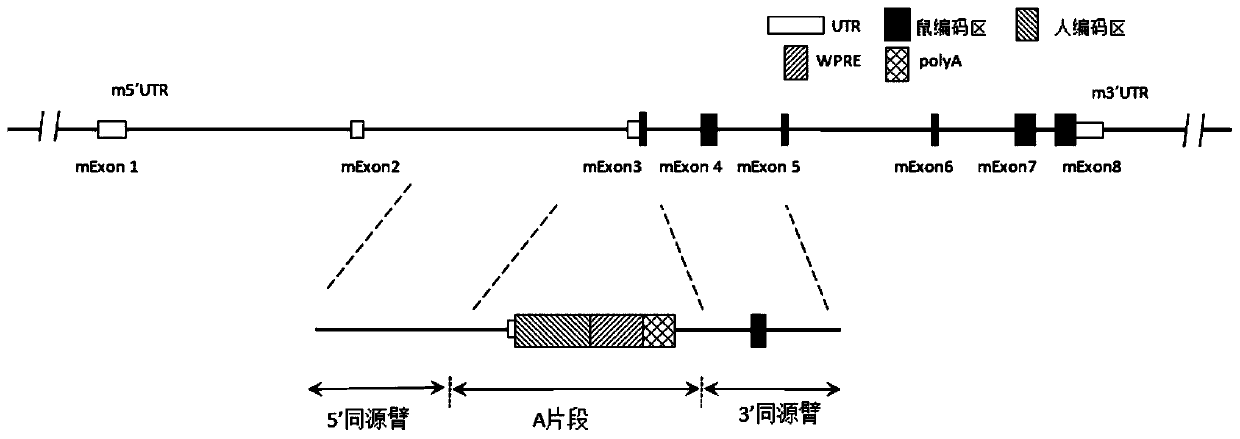Construction method and application of humanized cell factor IL15 gene modified non-human animal
A non-human animal and genetic modification technology, applied in the fields of plant genetic improvement, chemical instruments and methods, botany equipment and methods, etc., can solve the problems of low differentiation efficiency of human NK and T cells
- Summary
- Abstract
- Description
- Claims
- Application Information
AI Technical Summary
Problems solved by technology
Method used
Image
Examples
Embodiment 1I
[0249] Example 1 IL15 Gene Humanized Mice
[0250] In this example, a non-human animal (such as a mouse) is modified so that the non-human animal contains a nucleotide sequence encoding human IL15 protein, and a genetically modified non-human animal that can express human or humanized IL15 protein is obtained. . Mouse IL15 gene (NCBI Gene ID: 16168, Primary source: MGI: 103014, UniProt ID: P48346) (based on the transcript of NM_001254747.1 → NP_001241676.1, its mRNA sequence is shown in SEQ ID NO: 1, the corresponding The amino acid sequence is shown in SEQ ID NO: 2) and human IL15 gene (NCBI Gene ID: 3600, Primary source: HGNC: 5977, UniProt ID: P40933) (based on the transcript of NM_000585.4 → NP_000576.1, its mRNA sequence As shown in SEQ ID NO: 3, the corresponding amino acid sequence is shown in SEQ ID NO: 4) The comparison diagram is shown in figure 1 shown.
[0251] In order to achieve the purpose of the present invention, the gene sequence encoding human IL15 protei...
Embodiment 2
[0302] Example 2 Double or polygenic humanized mice containing human IL15 cytokine
[0303] Using the method or the prepared IL15 mice can also prepare double-gene humanized or multi-gene humanized mouse models. For example, in the aforementioned Example 1, the fertilized egg cells used in the microinjection and embryo transfer process were selected from fertilized egg cells derived from other genetically modified mice, for example, the fertilized egg cells of CSF2 or IL3 or CSF1 gene humanized mice were selected according to this method. Methods Through gene editing, a double-gene humanized mouse model with CSF2 or IL3 or CSF1 gene and IL15 gene modification can be further obtained. The homozygous or heterozygous IL15 mice obtained by this method can also be mated or fertilized in vitro with other genetically modified homozygous or heterozygous mice, and their offspring can be screened. According to the law of Mendelian inheritance, there is a certain probability of obtaining...
Embodiment 3
[0304] Example 3 Immune Reconstitution and Verification of Genetically Engineered Humanized Mice Containing Human IL15 Cytokines
[0305] The genetically engineered humanized homozygous mice (B-NDG background, n=15) and B-NDG mice (n=19) of the human IL15 cytokine prepared by 6-week-old embodiment 1 were selected, and irradiated ( 2.0Gy) and then inject 1.5×10 5 Human hematopoietic stem cells (CD34+) are used to reconstitute the immune system in mice, and the successful standard of reconstitution is that the ratio of hCD45 to the total living cells is ≥ 25%. Peripheral blood (PB) was collected every four weeks after transplantation for flow cytometry to evaluate whether the reconstitution was successful, and the survival of the mice was recorded. The results of flow cytometry showed that the expression of human leukocyte surface molecular markers (CD45 + ) cells, but the proportion of CD45+ cells in IL15 mice and the number of successfully reconstituted cells were significan...
PUM
 Login to View More
Login to View More Abstract
Description
Claims
Application Information
 Login to View More
Login to View More - R&D
- Intellectual Property
- Life Sciences
- Materials
- Tech Scout
- Unparalleled Data Quality
- Higher Quality Content
- 60% Fewer Hallucinations
Browse by: Latest US Patents, China's latest patents, Technical Efficacy Thesaurus, Application Domain, Technology Topic, Popular Technical Reports.
© 2025 PatSnap. All rights reserved.Legal|Privacy policy|Modern Slavery Act Transparency Statement|Sitemap|About US| Contact US: help@patsnap.com



